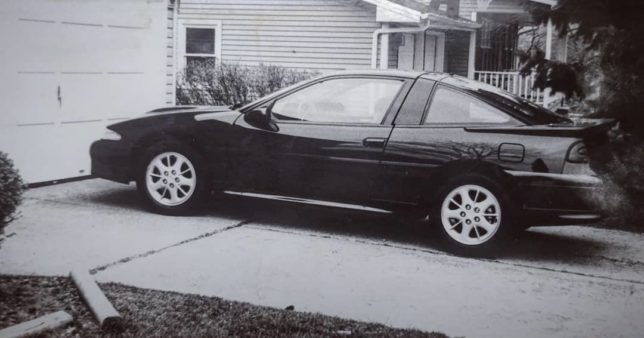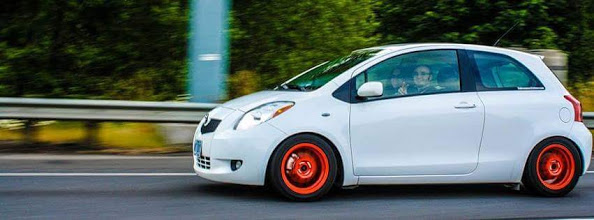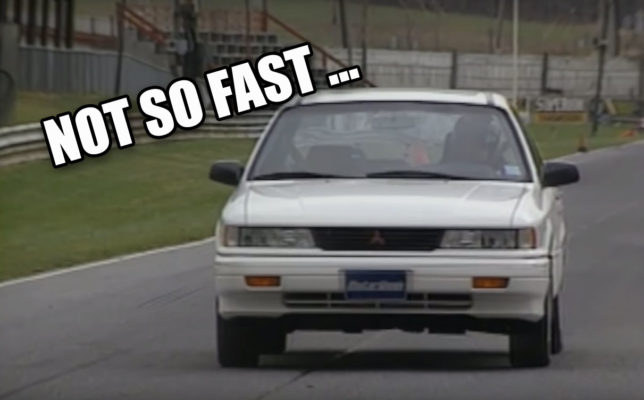Something occurred to me today as I was watching one of those old MotorWeek videos; this one was about the 1990 Mitsubishi Galant GSX. I realized today’s cars are faster than ever before, and we’re living in a modern muscle car era. A time where even a ho-hum car offers impressive performance compared to cars 25 years ago. Conversely, I also realized a lot of the cars from my youth are slower than I remember.

In 1990, I was 12 years old and my family was ordering a brand-new ’90 Mitsubishi Eclipse GS. It was the non-turbo model but still had the 2.0-liter 4G63 engine mated to a five-speed manual. My dad and I had seen the Eclipse at the Minneapolis Auto Show in 1989 and he fell in love with it, especially after he saw it had a back seat so he could shoehorn us kids in there. A while later, he and I made a trip to White Bear Mitsubishi to test drive the car, but the dealer didn’t have one on the lot yet. Instead, they had the ’90 Galant GS sedan with the same engine and transmission. Powered by the same smooth 4G63 engine in the Eclipse, the Galant offered similar performance: revved to 7,000 rpm, had a slick-shifting manual transmission, and sounded great. I remember my dad driving it pretty hard on the test drive to get a feel for its performance. Twelve-year-old Andy remembers thinking it was really fast. And part of this is because I remember my dad turning to me and saying, “The Eclipse will be even faster than this!” I thought that was pretty awesome. We ended up getting that ’90 Eclipse and later, a ’94 in the same spec years later (see above).

Today, I was viewing that above-mentioned MotorWeek video and watched as the fast Galant from my childhood memory sprinted from 0–60 in, well, 9.1 seconds and ran the quarter mile in a leisurely 17.1 seconds at 82 MPH. Suddenly I realized that my whole childhood was a lie. The Galant (and our non-turbo Eclipses) weren’t really that fast, at least not compared to similar cars today. This might sound like a “no duh” statement, but when you grow up thinking a certain car is a bastion of performance, then suddenly realize that your 2007 Toyota Yaris is likely faster 0–60 than one of the cars you idolized, it’s a bit disappointing. It’s like rewatching your favorite, “amazing” sci-fi movie from your childhood as an adult, and realizing how bad it really was.
We’ve seen this same disbelief with the boomer generation and their muscle cars. Those vehicles were a sensory experience to be certain. Big V-8 engines, hairy-chested American muscle car noises, and none of the modern driving aids made these things much more raw than cars of today. And talk to guys that had them (my late father included), and they’d tell you how fast their ’69 Camaro was. How that Mustang of theirs couldn’t be beaten. How cars nowadays can’t hold a candle to that old ‘Merican performance from the ’60s. Yeah, about that …
Super Chevy magazine ran a battery of tests on a ’69 Camaro SS with a 350 V-8 back in 2008, and the results? Well, kind of tepid. The iconic pony car ran 0-60 in 7.5 seconds and a quarter mile time of 15.4 @ 90 mph. You know what else does 0-60 in 7.5 seconds? A 2019 Toyota Corolla. Yes, the Camaro would best the Corolla’s 16.0 quarter-mile time by 0.6 seconds, but you see the point. Acceleration is only part of the performance story, or course, as handling and braking have improved. Perhaps a 50 year old Camaro is one thing, but even a 25 year old car is generally outperformed by modern cars with far less sporting intentions.

A 2020 Kia Soul with a turbocharged 2.0-liter engine will do 0–60 in a scant 6.5 seconds. This would best the boosted 1990 Mitsubishi Eclipse GSX— one of my dream cars as a teen—by 0.3 seconds. It just goes to show that modern cars have become much more optimized for performance (and fuel economy, frankly) right from the factory. Sure, you could build that Eclipse into a 550 hp monster with a few thousand dollars and run circles around that hamstermobile. But you get the point.
In case you haven’t gotten what I’m talking about, I recently drove a JDM Mitsubishi RVR powered by that non-turbo 4G63 engine in the Galant and Eclipse. See, my first car was a 1992 Mitsubishi Expo LRV (the U.S. equivalent of the RVR), and I always dreamed of having the 4G63 Eclipse engine in one (especially a turbo version). It just so happens the JDM RVR had a 4G63 option from the factory (in both non-turbo and turbocharged versions). This model was a non-turbo AWD version—essentially a Galant GSX in tiny van format. I even drove 2.5 hours up to Seattle to check it out with cash in hand. Needless to say, I was kind of disappointed by the performance. It’d been years since I drove either an Eclipse or an Expo LRV. While I had it in my head that this was going to be the dream car I’d wanted since ’92, with each shift it became apparent that it simply wasn’t. Performance merely felt adequate. Yes, it revved to 7,000 RPM and the engine felt healthy, but it didn’t meet my childhood expectations. In fact, if you go just by the numbers, our 2017 Mitsubishi Mirage with a paltry 78 HP and 1.2-liters of displacement would run to 60 MPH in about the same time as that RVR. For what it’s worth, I’d still buy a JDM Mitsubishi RVR Super Sports Gear with the boosted 4G63 turbo if and when I can find one.
The point here is that even our slower cars from the 2010s are still faster than cars 20+ years ago as a whole. And some of those “fast” and aspirational childhood cars weren’t really all that fast compared to some not-so-fast cars from today. Still, nostalgia is a powerful thing, and I still love seeing and owning these cars from my childhood, whether they’re fast or not.


Good old memories……..
Hermine.